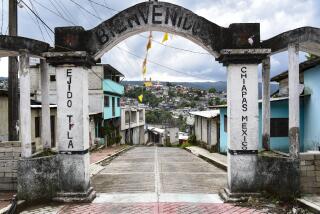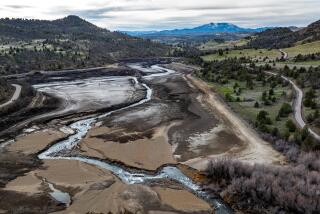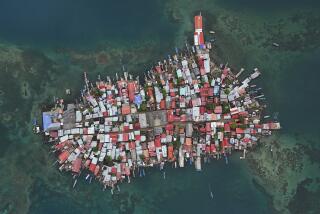Indians Ousted by Sandinistas Find Houses, Crops Gone : Exiles Back at Hallowed River
- Share via
ULWAS, Nicaragua — On the day the Miskito Indians of Ulwas came back to their homeland, more than three years of bitter exile ended with a double ritual of joy.
First, the Indians held a Moravian Protestant church service on the site of their destroyed village. Then they trekked to their hallowed Coco River, a mile away, and bathed in its shining waters.
“We gave thanks to God, and then we all went in. And we drank the water, drank a lot,” said Gordiano Mitchell, a village leader.
Nicaragua’s Sandinista government cleared the people out of Ulwas in February, 1982, and burned down their houses. It was part of a massive relocation aimed at isolating anti-Sandinista Indian guerrillas in the borderlands of northeastern Nicaragua along the Coco River.
To Resettlement Camps
Thirty-eight river communities like Ulwas were vacated and burned. About 10,000 Indians were put in the Tasba Pri resettlement camps, far from the area of the Nicaragua-Honduras border.
Thousands more Indians were evacuated from other areas of northeastern Nicaragua, and many thousands more fled across the Coco River into nearby Honduras.
The forced evacuation drew strong criticism from abroad. And it further alienated Indian and black Nicaraguans living along the country’s isolated eastern coast, where resistance to the Sandinista revolution already was widespread.
Many of the villagers who fled to Honduras joined the anti-Sandinista guerrillas. It became increasingly obvious that the evacuation had been a mistake by the Managua government.
Cease-Fire Agreement
In June, the government signed a cease-fire agreement with a faction of Indian guerrillas and announced that the Miskitos of the Coco River would be returned to their villages.
Ulwas was the first village along the river to be reoccupied. A caravan of government and private trucks, escorted by army troops, brought 35 families to the village site July 12 and left them here with corrugated metal roofing sheets and supplies of beans, rice, flour and sugar.
“We came back happy, singing,” said Fidencio Hemlock, 33.
But some did not come back from the resettlement camp.
“Old people died, and young people too, from sicknesses,” Hemlock said. “Yes, many people died.”
“Life was hard in the camp,” Gordiano Mitchell said. “Everything was scarce. We were very hungry.”
Life continues to be hard in Ulwas.
Before the evacuation, the people of Ulwas lived in wooden houses raised on stilts above the damp bottom land of the Coco River. They raised pigs and cows and cultivated fertile patches of corn and beans, bananas and manioc.
Swarms of Mosquitoes
Now the forlorn village site is overgrown with brush and weeds, overwhelmed by swarms of voracious mosquitoes.
The houses, the livestock and the crops are gone. The recently returned villagers shelter themselves from heavy rains under improvised lean-tos of corrugated metal. They survive on rationed staples provided by the government that many of them bitterly resent.
“They took us out at gunpoint, and look what we come back to,” said Nora Zuniga, 44. “They left us with nothing.”
Other villagers said that the government has promised to replace the livestock and bring in lumber to rebuild the houses. But it will take time.
Jose Lopez, 55, said mosquito netting is one of the village’s most urgent needs. Under a lean-to, Lopez pointed to a 2-year-old girl covered with welts from mosquito bites.
“The mosquitoes are eating the children alive,” he said. “We don’t have mosquito nets. They are very expensive.”
Rifles, Machetes Needed
Villagers also said they need fishhooks, hunting rifles and machetes to clear land for planting.
Some villagers were afraid to start clearing. Many areas along the Coco River are said to have been mined in the fighting between guerrillas and Sandinista troops.
At Santa Fe, another evacuated village, a mine explosion in mid-July killed six Indians who were preparing for their community’s homecoming.
Amid their homecoming hardships, what the villagers seemed to miss most of all were their relatives and friends who took refuge in Honduras. Several villagers implored a visitor to get word to the refugees to come back.
Celso Crawford, 50, said most of Ulwas’ residents crossed the river because they were afraid of the Sandinistas.
“We want them to come back now because we are here, this is our place,” he said. “The government has changed. It has set us free.”
The government is slowly returning other Indians to their villages on the Coco. Myrna Cunningham, who is the government representative in the Caribbean coast town of Puerto Cabezas, said the main obstacle in the project is a shortage of transportation.
“It is a process that I think is going to take the rest of the year,” Cunningham said in Puerto Cabezas, which is about 75 miles southeast of Ulwas and about 50 miles east of the Tasba Pri resettlement camps.
Swamps, Jungles
The river, the camp and the town are connected by rough roads through swamps, jungles and sandy pine barrens.
Until 1860, the east coast of Nicaragua--called the Mosquito Coast--was controlled by the British. Many of the Indian and black inhabitants still speak English.
The coastal area was an autonomous province known as the Mosquito Kingdom from 1860 to 1894, when the Nicaraguan government took control of it by force.
The area’s blacks and Indians--the latter members of the Miskito, Rama and Sumo tribes--have long sought a return to autonomous status. That is one of the demands of the guerrillas fighting the Sandinistas there.
The guerrillas in the Coco River area use the name Misura, a combination of Miskito, Sumo and Rama. They have been fighting the Sandinistas under an alliance with the U.S.-supported rebels of the Nicaraguan Democratic Force, known as the contras.
Mysterious Incident
In mid-June, a faction of the Misura made a cease-fire pact with the Sandinistas. Faction leader Eduardo Pantin was killed in a mysterious incident a few days later.
Nicaraguan Red Cross officials have said that according to witnesses, Pantin was killed accidentally when his pistol fell. But Steadman Fagoth, the top Misura leader, has accused the Sandinistas of assassinating him.
And Jose Gonzalez, the Sandinista army commander in Puerto Cabezas, said that Pantin died in “an obscure manner” while meeting with other Misura members.
Misura guerrillas loyal to Fagoth have continued to fight since the cease-fire.
“They have maintained a hard line of aggression against the revolution,” Gonzalez said. But he added that the Sandinistas “maintain communications with other leaders who are interested in the cease-fire.”
He said the reoccupation of the Coco River area does not depend on the cease-fire.
The Sandinistas also are preparing a plan to give a measure of autonomy to the east coast. It will include guarantees for local self-government and cultural preservation, officials have said.
They hope that the autonomy plan and the return of the Indians to the river will lead to pacification of the coastal area.
More to Read
Sign up for Essential California
The most important California stories and recommendations in your inbox every morning.
You may occasionally receive promotional content from the Los Angeles Times.










